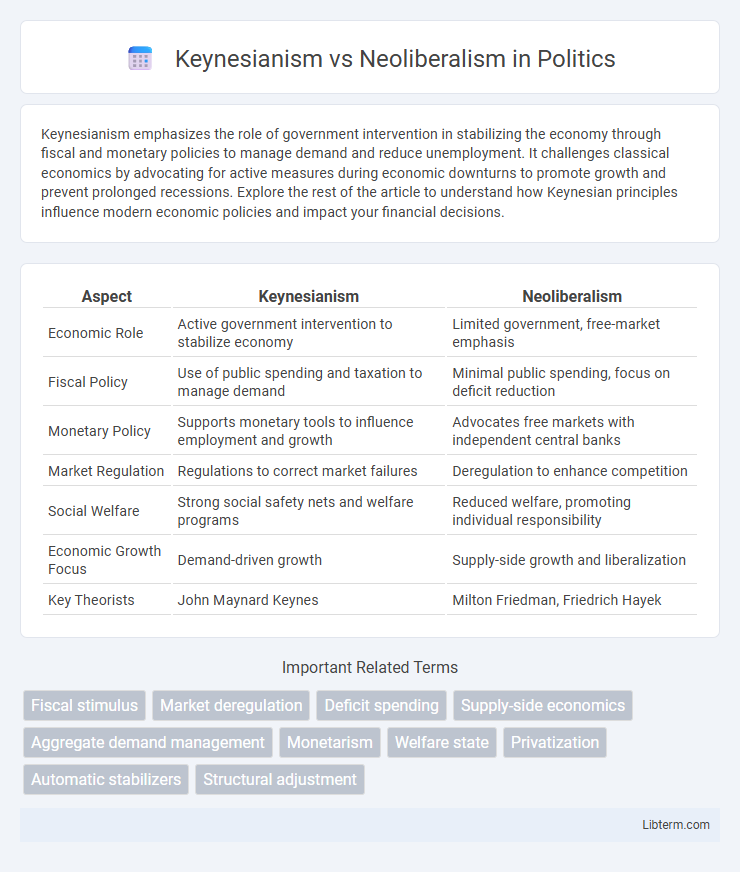Keynesianism emphasizes the role of government intervention in stabilizing the economy through fiscal and monetary policies to manage demand and reduce unemployment. It challenges classical economics by advocating for active measures during economic downturns to promote growth and prevent prolonged recessions. Explore the rest of the article to understand how Keynesian principles influence modern economic policies and impact your financial decisions.
Table of Comparison
| Aspect | Keynesianism | Neoliberalism |
|---|---|---|
| Economic Role | Active government intervention to stabilize economy | Limited government, free-market emphasis |
| Fiscal Policy | Use of public spending and taxation to manage demand | Minimal public spending, focus on deficit reduction |
| Monetary Policy | Supports monetary tools to influence employment and growth | Advocates free markets with independent central banks |
| Market Regulation | Regulations to correct market failures | Deregulation to enhance competition |
| Social Welfare | Strong social safety nets and welfare programs | Reduced welfare, promoting individual responsibility |
| Economic Growth Focus | Demand-driven growth | Supply-side growth and liberalization |
| Key Theorists | John Maynard Keynes | Milton Friedman, Friedrich Hayek |
Introduction to Keynesianism and Neoliberalism
Keynesianism emphasizes government intervention to stabilize economic fluctuations and promote demand-driven growth through fiscal policies. Neoliberalism advocates for free-market mechanisms, limited government interference, and deregulation to enhance economic efficiency and individual entrepreneurship. These contrasting frameworks shape contemporary debates on economic management and policy priorities.
Historical Origins and Development
Keynesianism originated in the 1930s during the Great Depression, based on John Maynard Keynes' theories advocating for active government intervention to manage economic cycles and stimulate demand. Neoliberalism emerged in the late 20th century as a reaction against Keynesian policies, emphasizing free markets, deregulation, privatization, and reduced government spending. The transition from Keynesian dominance to neoliberal policies began in the 1970s, influenced by stagflation and the rise of leaders like Margaret Thatcher and Ronald Reagan.
Core Principles of Keynesianism
Keynesianism centers on government intervention to manage economic cycles through fiscal policies like public spending and taxation adjustments, aiming to stabilize demand and reduce unemployment. It emphasizes the role of aggregate demand as the primary driver of economic growth and advocates for proactive policy measures during recessions to stimulate consumption. Unlike Neoliberalism, which promotes free markets and minimal state interference, Keynesianism supports a more active governmental role to ensure economic stability and social welfare.
Fundamental Tenets of Neoliberalism
Neoliberalism emphasizes free-market capitalism, deregulation, and reduced government intervention as core principles to foster economic growth and efficiency. It advocates for privatization of state-owned enterprises, lower taxes, and suppression of labor unions to promote individual entrepreneurship and competition. This contrasts with Keynesianism, which supports active government policies to manage economic cycles and ensure social welfare.
Policy Differences: Government Intervention vs Market Freedom
Keynesianism advocates for active government intervention through fiscal policies such as public spending and taxation to stabilize economic cycles and promote growth. Neoliberalism emphasizes minimal state interference, prioritizing free markets, deregulation, and privatization to enhance economic efficiency and individual entrepreneurship. The fundamental policy difference lies in Keynesian reliance on state-driven demand management versus Neoliberal confidence in self-regulating markets for resource allocation.
Economic Crises: Responses and Outcomes
Keynesianism advocates for government intervention through fiscal stimulus and public spending to mitigate economic crises, promoting demand-driven growth and reducing unemployment during downturns. Neoliberalism emphasizes market self-regulation, supply-side policies, and deregulation, aiming to restore economic stability by enhancing efficiency and incentivizing private sector investment. Empirical studies show Keynesian policies often lead to faster recovery in recessions, while neoliberal approaches focus on long-term growth but may prolong short-term unemployment and inequality.
Impact on Income Inequality and Social Welfare
Keynesianism emphasizes government intervention through fiscal policies to reduce income inequality and enhance social welfare by funding public services and social safety nets. Neoliberalism advocates for minimal state intervention, promoting free markets and deregulation, often leading to increased income inequality due to reduced redistribution and social spending. Empirical studies show Keynesian approaches correlate with lower Gini coefficients and stronger social programs, whereas neoliberal policies frequently coincide with rising inequality and weaker welfare systems.
Influence on Global Economic Policies
Keynesianism emphasizes government intervention through fiscal policies to stabilize economic cycles and promote employment, shaping post-World War II welfare states and the Bretton Woods system. Neoliberalism advocates for free-market principles, deregulation, and reduced state intervention, significantly influencing global economic policies from the 1980s, including structural adjustment programs by the IMF and World Bank. This ideological shift impacts trade liberalization, privatization, and monetary policy frameworks worldwide.
Contemporary Debates and Criticisms
Contemporary debates on Keynesianism and neoliberalism center on their differing approaches to government intervention and market regulation, with Keynesianism advocating for active fiscal policies to address economic fluctuations, while neoliberalism emphasizes deregulation and free-market solutions. Critics argue that Keynesian policies may lead to excessive government debt and inflation, whereas neoliberalism faces criticism for increasing income inequality and undermining social safety nets. Recent discussions also highlight the relevance of Keynesian stimuli during economic crises, contrasted with neoliberal calls for austerity and structural reforms.
Conclusion: Future Prospects and Relevance
Keynesianism emphasizes government intervention to stimulate demand and reduce economic volatility, making it relevant in times of crisis and recession. Neoliberalism prioritizes market efficiency, deregulation, and privatization, appealing to sustained growth and innovation in stable economic environments. The future economic landscape may require a hybrid approach, leveraging Keynesian stimulus during downturns and neoliberal policies to promote long-term growth and competitiveness.
Keynesianism Infographic

 libterm.com
libterm.com